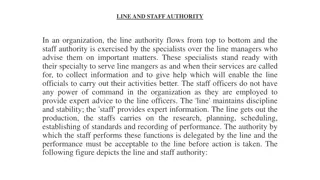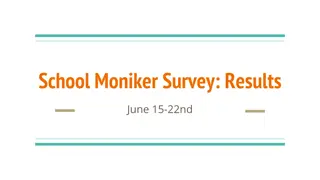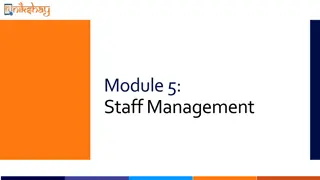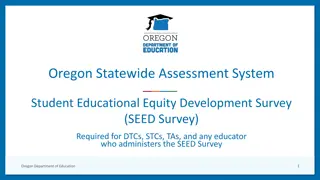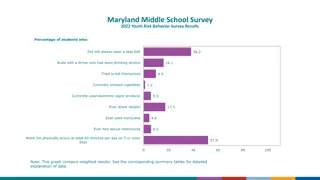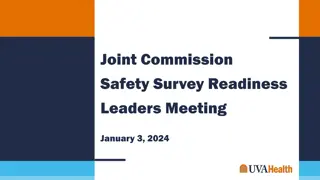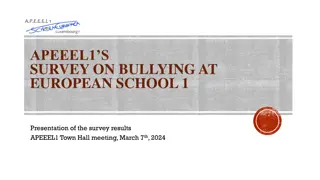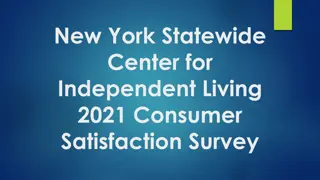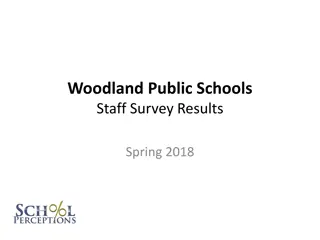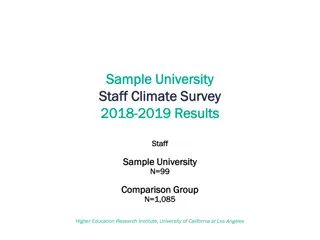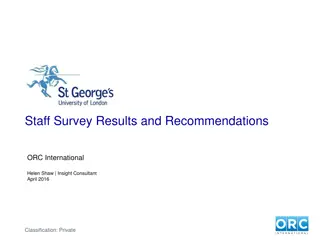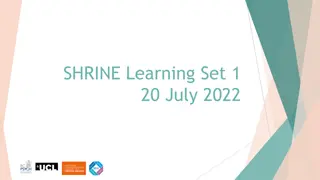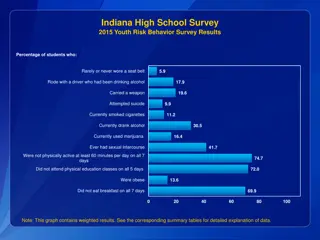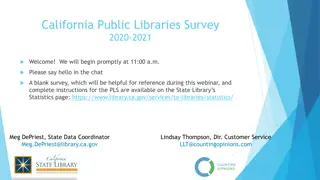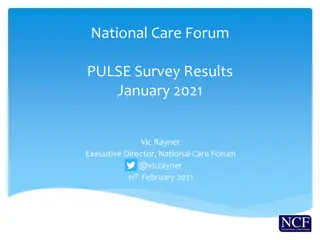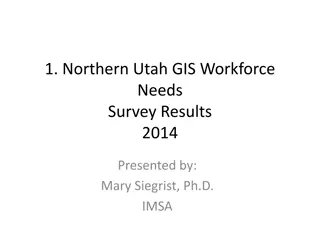Insights from School Staff Re-Opening Survey Results
Survey results from the first six weeks of school staff re-opening show concerns regarding safety measures, inadequate cleaning supplies, and district support for staff health. A significant proportion find implementing safety measures easy, but many express dissatisfaction with protocols and support. The survey highlights challenges faced by staff in maintaining a safe learning environment amidst the pandemic.
Download Presentation

Please find below an Image/Link to download the presentation.
The content on the website is provided AS IS for your information and personal use only. It may not be sold, licensed, or shared on other websites without obtaining consent from the author.If you encounter any issues during the download, it is possible that the publisher has removed the file from their server.
You are allowed to download the files provided on this website for personal or commercial use, subject to the condition that they are used lawfully. All files are the property of their respective owners.
The content on the website is provided AS IS for your information and personal use only. It may not be sold, licensed, or shared on other websites without obtaining consent from the author.
E N D
Presentation Transcript
Lessons Learned School Staff Re-Opening Survey Results Open 2 weeks (Sept. 21st Oct. 5th) 3,756 Responses (59% response rate) Intended to provide feedback on first six weeks of re-opening 6.2% Other 10.4% ESP 79.0% Certified 4.4% Admin
Proportion of Responses by School Staff on Large-Scale Surveys by Role Type 100% First Six Weeks Survey has comparable response rates to other large- scale surveys. ESPs often under-represented in survey responses. 90% 84.0% 79.0% 77.0% 76.8% 80% 70% 63.7% 60% 50% 40% 33.3% 30% 19.0% 17.2% 20% 10.5% 10.4% 10% 6.0% 5.5% 4.4% 4.0% 3.0% 0% Certified Administrator Education Support Professionals Calendar Survey (N =3,326) Staff Climate Survey (N = 3,315) Decision to Reopen Survey (N = 4,835) First 6 Weeks Survey (N = 3,757) Actual Proportion of Staff (N = 6,371)
Insufficient/inadequate cleaning and safety supplies 35%* 1.Comment: Is there anything else you would like to share about the measures and protocols our district is taking to keep students and staff healthy? (N =1,340) Protocols are not effective/enforceable for teaching and learning 22% Lack of concern by District about safety of staff 21% Stress is negatively impacting staff and students 15% Smoke days are stressful, unhealthy to be in buildings 8% Notification process for possible exposure is ineffective 8% *Theme percentages are close approximations based on searches for commonly used terms, but may not capture all nuanced sentiments or meanings. Multiple people performed analysis and compared codes throughout the process to improve precision.
Safety Measures 27% say implementing safety measuresis easy/very easy 60% believe there are about the right amount of safety measures (31% believe not enough and 9% believe too many ) 27% agree WCSD is concerned about the safety and health of its employees 30% agree WCSD has effectively notified students/staff about possible exposures The district provided virtually no safety materials for staff members. The one ~20oz. pump bottle of hand sanitizer is not enough for the school year. The disinfectant bottle full of water and dish soap was pitiful and appalling. -High School Teacher
Safety Measures How easy or difficult has it been to implement the COVID-related safety measures and protocols in your building? (N = 3,756) 50% 28.2% 27.9% 17.2% 15.4% 8.7% 2.6% 0% Very difficult Difficult Neither easy nor difficult Easy Very easy Not applicable, I am only working from home WCSD is concerned about the safety and health of its employees (N = 3,331) 50% 31.3% 23.3% 20.8% 18.2% 6.4% 0% Strongly disagree Disagree Neither agree nor disagree Agree Strongly agree WCSD has been effective in notifying students and staff about possible exposure to COVID-19 (N = 3,328) 50% 22.7% 22.5% 22.3% 19.1% 7.7% 5.7% 0% Strongly disagree Disagree Neither agree nor disagree Agree Strongly agree Not sure
Ensured devices and technology platforms (e.g. Teams) were adequate 31% Started the year fully distance learning or delayed school start 24% 2. Comment: Thinking back to the beginning of the school year, what are three things you, or the district, should have done differently? (N =2,660) Established reopening decisions and protocols earlier 17% Not allowed multiple learning models, or switching between models 17% Provided better training around distance learning for staff, students, families 10%
Devices and technology platforms are inadequate 38% Stress, burnout, workload, feeling under-valued 30% 3. Comment: What are three challenges you are experiencing? (N = 2,579) Difficulty of teaching multiple learning models 21% Safety protocols negatively impacting learning 12% Difficulty engaging students and families on distance learning 8%
Work Stress % of All Staff who agree they are burned out or tense, restless, or anxious at work over time* 100% We need to pick a learning designation and stick to it. It is too hard to continue to flip flop. We will get good at one or the other, but the lack of consistency has a terrible impact on both teaching and learning and morale. -Middle School Leadership 90% 76% 80% 74% 70% 72% 60% 46% 50% 44% 42% 39% 40% 43% 40% 39% 36% 30% 20% 10% 0% 2016-2017 2017-2018 2018-2019 2019-2020 2020-2021 I feel tense, restless, or anxious at work. I feel burnt out. I do not have sufficient time to complete all duties required of me. *Questions asked on Annual Staff Climate Survey in 2016-20
Work Stress % of Teachers who agree they are burned out or tense, restless, or anxious at work over time* 100% We are exhausted and cannot juggle all these options!!! PLEASE listen to us and stop killing your teachers!!! -Middle School Teacher 90% 90% 84% 80% 80% 70% 55% 60% 53% 50% 46% 50% 50% I have never been in such a hopeless, exhausted, emotionally deficient atmosphere as I am in now. -High School Teacher 48% 46% 40% 42% 30% 20% 10% 0% 2016-2017 2017-2018 2018-2019 2019-2020 2020-2021 I feel tense, restless, or anxious at work. I feel burnt out. I do not have sufficient time to complete all duties required of me.
Staff responses to the question "I feel burnt out." 100% Teachers, Psychologists, Instructional Aides/Teaching Assistants, Coaches, and Speech and Language Pathologists are most likely to strongly agree they are burnt out. 90% 80% 70% 60% 50% 40% 30% 20% 10% 0% Teacher (all subjects) Psychologist Instructional Aide, Teacher Assistant Instructional Coach, Implementation Specialist Speech Language Pathologist School Leadership (principal, assistant principal, or dean) Secretary, Registrar, Bookkeeper Counselor, Social Worker FACE Liaison, Student Graduation Advocate, Re- engagement Specialist, Truancy Officer Nutrition Services Staff Member Custodial Staff Member Transportation Staff Member, Bus Driver School Nurse, Health Aide, Physical Therapist, Occupational Therapist Librarian/Librarian Assistant Technology Specialist, Technology Coordinator, Educational Technology Specialist Strongly Disagree Disagree Agree Strongly Agree
Multiple Learning Models All Staff: % Who Feel Their School's In-Person or Distance Learning Model is Effective (N = 3,217) 100% 4.2% 18.3% Quite or Extremely Effective 18.5% 90% 14.1% 51.6% Quite or Extremely Effective 80% 70% 33.1% 34.7% Extremely effective Quite effective Somewhat effective Slightly effective Not at all effective 60% 50% 40% 29.4% 30.3% 30% 20% 13.8% 10% 16.8% 5.2% 0% In-Person Learning Distance Learning
Multiple Learning Models % of Teachers Who Rate the In-Person or Distance Learning Model at Their School as Quite/Extremely Effective 100% Distance Learning effectiveness rated lower than In-Person learning effectiveness by teachers. 1/3 of Distance Learning Teachers believe distance learning is quite/extremely effective. 90% 80% 70% 63.6% 60% 46.5% 50% 44.1% 40.0% 40% 31.6% 30% 22.0% 20% 14.7% 12.3% 10% 0% In-Person Teachers (N = 827) Hybrid Teachers (N = 539) Distance Teachers (N = 304) Combination Teachers (N = 867) In-Person Learning Model Distance Learning Model
Concern for Students All Staff: How concernedare you about each of the following... (N = 3,274) 22.4% 21.4% 27.4% 16.0% 12.8% Students' behavior 15.8% 18.3% 28.0% 21.8% 16.1% Students' relationships with adults 9.9% 16.0% 27.3% 25.3% 21.5% Students' peer relationships 6.9% 11.8% 17.5% 25.0% 38.8% Students' access to technology needed for learning 3.8% 8.8% 23.5% 31.7% 32.1% Students' social-emotional well-being 2.7% 6.9% 16.9% 35.0% 38.4% Students' academic growth 0% 10% 20% 30% 40% 50% 60% 70% 80% 90% 100% Not at all concerned Slightly concerned Somewhat concerned Quite concerned Extremely concerned
Teacher Confidence Teachers: How confident are you that you are providing effective instruction to the following student groups right now? (N = 2,349) 100% 3.9% 6.4% 8.5% 12.8% Quite or Extremely Confident 11.7% 23.7% Quite or Extremely Confident 8.9% 18.1% 31.9% Quite or Extremely Confident 35.0% Quite or Extremely Confident 90% 17.3% 49.6% Quite or Extremely Confident 80% 23.4% 19.0% 23.3% 70% 31.5% 31.1% 60% 23.9% 28.7% 27.6% 50% 40% 25.2% 24.5% 30% 22.7% 21.2% 44.3% 20% 14.3% 20.7% 10% 16.7% 16.1% 10.9% 0% Academically advanced Students with special learning needs (e.g., IEP) Students learning English Students experiencing trauma Students with inadequate technology Not at all confident Slightly confident Somewhat confident Quite confident Extremely confident
Teacher Confidence to Instruct Special Populations We have a significant amount of pressure to address past due IEP evaluations, but it was difficult to reach many students during the full distance learning days, despite interventions/assistance available at the school. -Psychologist, Middle School Teaching with a mask. My [English Learner] students need to see my mouth and hear my voice for correct pronunciation of sounds. My voice is muffled, and I have a hard time hearing them when they speak to me. -Instructional Aide, Elementary School On [distance learning] days, students have difficulty accessing tools on various devices. We need more devices in our school to practice logging on. The level of trauma and lack of resources seems to be severely under appreciated. The students are watching siblings and dealing with abuse. -Elementary Teacher -Middle School Teacher
Engagement in Virtual Learning Teachers Only: In the past two weeks, how many of your students regularly participated in your virtual classes? (N = 2,426) 50% 23.7% 23.1% 22.3% 18.4% 6.6% 5.9% 0% Almost no students A few students About half of my students Most students Almost all students I did not teach virtual classes in the past two weeks. Teachers Only: In the past two weeks, how engaged have students been in your virtual classes? (N = 2,425) 50% 36.6% 24.8% 21.7% 6.4% 5.8% 4.7% 0% Not at all engaged Slightly engaged Somewhat engaged Quite engaged Extremely engaged I did not teach virtual classes in the past two weeks
Attitudes towards Leadership Staff Perceptions of Their School's Leadership During Reopening (N = 3,225) My school's leadership applies rules consistently to all staff at my school. 5.6% 8.0% 12.7% 30.2% 43.5% Communication from my school's leadership has been very clear during our re-opening process. 6.6% 10.0% 12.5% 30.4% 40.4% My school's leadership is working hard to ensure staff feel safe. 4.6% 6.4% 10.3% 30.8% 47.8% My school's leadership is working hard to support staff during re- opening. 4.1% 5.5% 9.2% 29.3% 52.0% 0% 10% 20% 30% 40% 50% 60% 70% 80% 90% 100% Strongly disagree Disagree Neither agree nor disagree Agree Strongly agree
Attitudes towards Leadership School Leaders' Perception of District Leadership (N = 154) Communication from district leadership about protocols for school closures has been clear. 11.7% 37.0% 21.4% 24.0% 5.8% I feel well-supported by my Area Superintendent during my school's re-opening 7.8% 12.3% 22.1% 33.8% 24.0% 0% 10% 20% 30% 40% 50% 60% 70% 80% 90% 100% Strongly disagree Disagree Neither agree nor disagree Agree Strongly agree
Provide better/more consistent technology and platforms for students and staff 38% Suspend time-consuming initiatives (SLOs, assessments, attendance) 16% 4. Comment: Given our district's limited resources, how might you recommend fixing those challenges? (N = 2,579) Provide dedicated distance learning teachers/reduce # of models 16% Secure more funding for public education (positions, compensation) 12% Provide more prep periods or days for teachers 7%
Solutions to Challenges Teachers Only: What additional resources do you need this year, if any? (select all that apply; N = 2,450) Time to effectively implement my school's learning model Professional learning to support distance learning Technical/IT support More opportunities to collaborate with coworkers Diagnostic tools to understand where students are in their learning The flexibility to focus on standards from the students' previous grade Professional learning on supporting students with IEPs Counseling services to support students Professional learning on supporting students social and emotional needs Professional learning on supporting students who are English Learners Professional learning on family engagement Professional learning on supporting academically advanced students I do not need support in any of these areas Other (please specify) Time and practice with multiple platforms as well as help with truancy and students not attending. 64.7% 39.6% 39.6% 36.0% 26.2% 21.3% 16.6% 14.9% 13.6% 11.3% 10.4% 9.1% 6.0% 17.9% -Elementary Teacher Technology that can support a distance learning model (loads efficiently, has speakers and a camera that work, has sufficient memory to run without delays). -Elementary Teacher
Solutions to Challenges All Staff: Which of the following social and emotional supports do you need, if any (select all that apply; N = 3,206) I don't have time for professional learning. -Middle School Counselor More opportunities to collaborate or engage with other staff 36.4% I do not need any of these supports 32.0% I have no idea what I need. I just feel like crying every day. No matter in person or smoke day DL, I feel like it s just not good enough instruction. Other (please specify) 25.6% Professional learning or resources on how to support my students social and emotional well-being 20.6% -Elementary Teacher Professional learning or resources on how to support my own social and emotional well-being 17.5% Professional learning or resources on how to support staff s social and emotional well-being 14.0%
School staff support each other 38% 5. Comment: What are three areas that are working well at your school? (N = 2,415) Strong school-based leadership 29% Smaller in-person class sizes 16% Students following safety protocols 16% Student laughter can be heard both in class and virtually. May seem silly but it is the reason we walk into our buildings every day! -Middle School Teacher
Thank You! Results of all reopening surveys available here: https://www.washoeschools.net/Page/15038 Spring Distance Learning Survey June Reopening Survey July Family Learning Model Selections Staff Check-In on First 6 Weeks of Reopening





